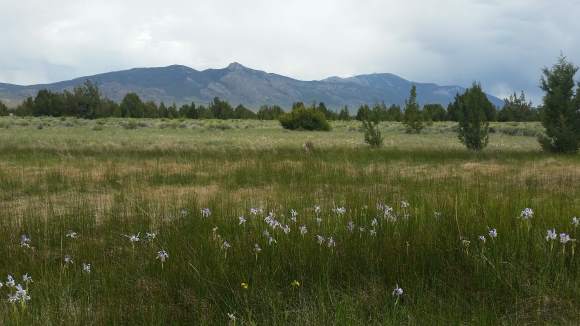
Wild Irises in Spring Valley
By Will Falk
The Swamp Cedars in Spring Valley, Nevada have grown long memories. They stand on the valley floor under the bright Great Basin stars where the skies are still unspoiled by the encroaching glow of electricity. Beneath the trees’ branches, the blue petals of wild irises flutter in the breeze. All of them – the trees, the flowers, the stars – sway to the soft melodies played by the valley’s bubbling springs.
Most of the Swamp Cedars’ memories are pleasant. Carried by glaciers to the valley floor sometime in the last two and a half million years, the Swamp Cedars remember when wooly mammoths plodded through the Great Basin. The wind through their leaves whispers of a time when the Swamp Cedars trembled under the shadow of great teraton birds who rode the skies with their 25-foot wingspans. When wild horses stop at the springs to share a drink with the Swamp Cedars, the trees tell stories of the fleet native horses and camels that once ran the open spaces of North America.
Dawn in Spring Valley still carries the hint of curiosity the Swamp Cedars felt on that morning so many thousands of years ago when they watched the first humans walk from the foothills to rest in the welcome shade the trees offered. They learned to expect the humans regularly as they gathered under the trees for sacred ceremonies. They listened as the humans called themselves “Newe” and the trees learned that the word meant, “people.”
The Newe returned often to the Swamp Cedars for their ceremonies and the trees took delight with the Newe as old friends embraced after several seasons apart, as young people became lovers, and as information was shared about the year’s pinyon pine nut harvest.
A few of the memories are extremely painful. The Swamp Cedars recall when a different kind of human first arrived in Spring Valley. These humans were pale of skin and rode what the trees recognized as horses though they were a different species of horse than the native horses that had long since been lost. At first, there were just a few of the pale humans, but the trickle turned into a flood. The Swamp Cedars wince as they relive their first experience of steel – the excruciating pain that came when the first ax drove deep into living Swamp Cedar wood.
Worst of all, the Swamp Cedars witnessed the Newe screaming as the blue-clad humans on horses rode them down, the puffs of white smoke that turned into a haze, and the sharp cracks of rifle fire. The Swamp Cedars still recoil from the taste of blood in the soil when the bubbling springs turned red.
Read the full article on the DGR News Service.
